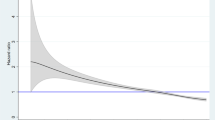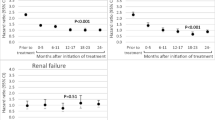Abstract
Introduction
Bisphosphonates are used worldwide to treat osteoporosis and, thus, to prevent fractures. Though they have been proven in clinical trials to avoid some fractures, their effectiveness in reducing hip fractures is unclear. The aim of the present study was to explore the relationship between bisphosphonate use and hip fracture trends in Spain.
Methods
For this purpose, an ecologic study spanning 2002 to 2008 was conducted in Spain. Consumption data were obtained from the Spanish Ministry of Health and Social Policy. The number of hip fractures was obtained from hospital discharges; annual hip fracture rates were determined and standardized using the Spanish 2002 population census. A linear regression was performed between fracture rate and use of bisphosphonates; R 2 and Pearson correlation coefficient were calculated.
Results
From 2002 to 2008, dispensed prescriptions of bisphosphonates in Spain increased from 3.28 to 17.66 DDD/1,000 inhabitants per day. In the same period, the crude hip fracture rate increased from 2.85 to 3.02 cases per 1,000 inhabitants older than 50 years; however, when age standardized rates were estimated, the rate declined from 2.85 to 2.79. Analyzed by sex, the standardized rate for men slightly increased from 1.45 to 1.48, while for women the rate significantly dropped from 4.00 to 3.91.
Conclusion
A small effect of bisphosphonates on hip fracture rates can not be ruled out; however, other factors might partially explain this decline. Assuming this medication was the only cause for hip fracture rate reduction, the elevated medication cost to avoid a single hip fracture makes it necessary to explore less expensive interventions.


Similar content being viewed by others
References
Cummings-Vaughn LA, Gammack JK (2011) Falls, osteoporosis, and hip fractures. Med Clin North Am 95:495–506
Haentjens P, Magaziner J, Colón-Emeric CS, Vanderschueren D, Milisen K, Velkeniers B, Boonen S (2010) Meta-analysis: excess mortality after hip fracture among older women and men. Ann Intern Med 152:380–390
Haleem S, Lutchman L, Mayahi R, Grice JE, Parker MJ (2008) Injury. Mortality following hip fracture: trends and geographical variations over the last 40 years. Injury 39:1157–1163
National Statistics Institute (2012) Population in Spain. http://www.ine.es/
de Felipe R, Cáceres C, Cimas M, Dávila G, Fernández S, Ruiz T (2010) Clinical characteristics of patients under treatment for osteoporosis in a Primary Care Centre. Who do we treat? Aten Primaria 42:559–563
Duarte J, Bolge S, Sen S (2007) An evaluation of patients’ preferences for osteoporosis medications and their attributes: the PREFER-International study. Clin Ther 29:488–503
Melton LJ 3rd, Kanis JA, Johnell O (2005) Potential impact of osteoporosis treatment on hip fracture trends. J Bone Miner Res 20:895–897
Shane E, Burr D, Ebeling PR, Abrahamsen B, Adler RA, Brown TD, Cheung AM, Cosman F, Curtis JR, Dell R, Dempster D, Einhorn TA, Genant HK, Geusens P, Klaushofer K, Koval K, Lane JM, McKiernan F, McKinney R, Ng A, Nieves J, O'Keefe R, Papapoulos S, Sen HT, van der Meulen MC, Weinstein RS, Whyte M, American Society for Bone and Mineral Research (2010) Atypical subtrochanteric and diaphyseal femoral fractures: report of a task force of the American Society for Bone and Mineral Research. J Bone Miner Res 25:2267–2294
Morgenstern H (1982) Uses of ecologic analysis in epidemiologic research. Am J Public Health 72:1336–1344
http://www.imi-protect.eu/documents/DUinventory_2011_6_WORD97-2003.pdf.
Lunde PKM, Baksaas I, Halse M, Strommes B, Aeydvin K (1979) The methodology of drug utilization studies. In: Bergman U, Grimsson A, Wahba AHW, Werterholm B (ed) Studies in drug utilization. WHO Regional Office for Europe, Copenhagen, pp 17–28
WHO Collaborating Centre for Drug Statistics Methodology (2007) Complete ATC index. http://www.whocc.no/atcddd/
Ministerio de Sanidad, Servicios Sociales e Igualdad (2012) Portal estadístico. http://pestadistico.msc.es/PEMSC25/ArbolNodos.aspx
http://www.msc.es/biblioPublic/publicaciones/recursos_propios/infMedic/docs/vol34n3SubgrATCppiosActivos.pdf. Accesed 1 April 2012
http://stat.ethz.ch/R-manual/R-patched/library/stats/html/summary.lm.html
http://www.nice.org.uk/. Accesed 1 April 2012
Chesnut CH III, Skag A, Christiansen C, Recker R, Stakkestad JA, Hoiseth A, Felsenberg D, Huss H, Gilbride J, Schimmer RC, Delmas PD, Oral Ibandronate Osteoporosis Vertebral Fracture Trial in North America and Europe (BONE) (2004) Effects of oral ibandronate administered daily or intermittently on fracture risk in postmenopausal osteoporosis. J Bone Miner Res 19:1241–1249
Black DM, Cummings SR, Karpf DB, Cauley JA, Thompson DE, Nevitt MC, Bauer DC, Genant HK, Haskell WL, Marcus R, Ott SM, Torner JC, Quandt SA, Reiss TF, Ensrud KE (1996) Randomised trial of effect of alendronate on risk of fracture in women with existing vertebral fractures. Lancet 348:1535–1541
Black DM, Delmas PD, Eastell R, Reid IR, Boonen S, Cauley JA, Cosman F, Lakatos P, Leung PC, Man Z, Mautalen C, Mesenbrink P, Hu H, Caminis J, Tong K, Rosario-Jansen T, Krasnow J, Hue TF, Sellmeyer D, Eriksen EF, Cummings SR, for the HORIZON Pivotal Fracture Trial (2007) Once-yearly zoledronic acid for treatment of osteoporosis. N Engl J Med 356:1809–1822
McClung MR, Geusens P, Miller PD, Zippel H, Bensen WG, Roux C, Adami S, Fogelman I, Diamond T, Eastell R, Meunier PJ, Reginster JY, for the Hip Intervention Program (HIP) Study Group (2001) Effect of risedronate on the risk of hip fracture in elderly women. N Engl J Med 344:333–340
Wells GA, Cranney A, Peterson J, Boucher M, Shea B, Robinson V, Coyle D, Tugwell P (2008) Alendronate for the primary and secondary prevention of osteoporotic fractures in postmenopausal women. Cochrane Database Syst Rev (1):CD001155
Feldstein AC, Weycker D, Nichols GA, Oster G, Rosales G, Boardman DL, Perrin N (2009) Effectiveness of bisphosphonate therapy in a community setting. Bone 44:153–159
Erviti J, Timoner J, Alonso A, Gorricho J, López A, Huerta C, Oliva B, Gil M, De Abajo F (2011) Oral bisphosphonates and hip fracture risk in elderly women. Pharmacoepidemiol Drug Saf 20:S28
Park-Wyllie LY, Mamdani MM, Juurlink DN, Hawker GA, Gunraj N, Austin PC, Whelan DB, Weiler PJ, Laupacis A (2011) Bisphosphonate use and the risk of subtrochanteric or femoral shaft fractures in older women. JAMA 305:783–789
Schilcher J, Michaëlsson K, Aspenberg P (2011) Bisphosphonate use and atypical fractures of the femoral shaft. N Engl J Med 364:1728–1737
Sellmeyer DE (2010) Atypical fractures as a potential complication of long-term bisphosphonate therapy. JAMA 304:480–484
Wang Z, Bhattacharyya T (2011) Trends in incidence of subtrochanteric fragility fractures and bisphosphonate use among the US elderly, 1996–2007. J Bone Miner Res 26:553–560
Fisher A, Martin J, Srikusalanukul W, Davis M (2010) Bisphosphonate use and hip fracture epidemiology: ecologic proof from the contrary. Clin Interv Aging 5:355–62
Hernández JL, Olmos JM, Alonso MA, González-Fernández CR, Martínez J, Pajarón M, Llorca J, González-Macías J (2006) Trend in hip fracture epidemiology over a 14-year period in a Spanish population. Osteoporos Int 17:464–470
Guilley E, Chevalley T, Herrmann F, Baccino D, Hoffmeyer P, Rapin CH, Rizzoli R (2008) Reversal of the hip fracture secular trend is related to a decrease in the incidence in institution-dwelling elderly women. Osteoporos Int 19:1741–1747
Brauer CA, Coca-Perraillon M, Cutler DM, Rosen AB (2009) Incidence and mortality of hip fractures in the United States. JAMA 302:1573–1579
Abrahamsen B, Vestergaard P (2010) Declining incidence of hip fractures and the extent of use of anti-osteoporotic therapy in Denmark 1997–2006. Osteoporos Int 21:373–830
Barba R, Losa JE, Guijarro C, Zapatero A (2006) Reliability of minimal basic data set in the diagnosis of thromboembolic disease. Med Clin 127:255–257
Author information
Authors and Affiliations
Corresponding author
Rights and permissions
About this article
Cite this article
Arias, L.H.M., Treceño, C., García-Ortega, P. et al. Hip fracture rates and bisphosphonate consumption in Spain. An ecologic study. Eur J Clin Pharmacol 69, 559–564 (2013). https://doi.org/10.1007/s00228-012-1337-z
Received:
Accepted:
Published:
Issue Date:
DOI: https://doi.org/10.1007/s00228-012-1337-z




